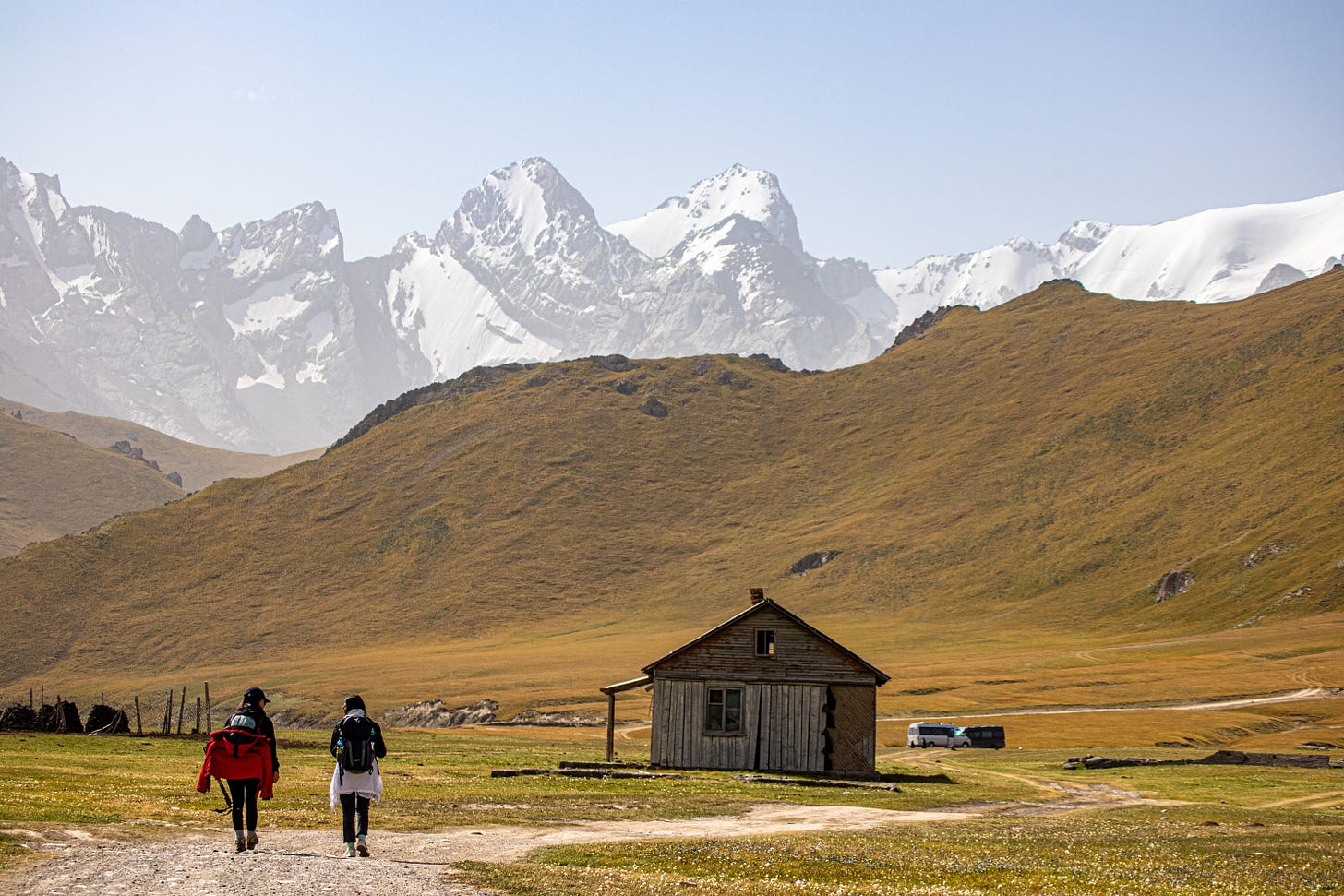The "lake coming in", Kel Suu Lake, Kyrgyzstan
A taste of nomads life and one of the most amazing landscapes I've ever seen.
In the summer of 2021, I spent around 3 months in Kyrgyzstan. As you might know by now from my first post of this series, I volunteered for a contemporary art association, and thanks to this, I was able to meet a lot of nice people.
In the previous post, I talked about a weekend trip to Sary Chelek National Park, and that this trip was the first one with Timur and Kina, another trip that I did with them was to Kel Suu Lake, yes another lake, the main attractions in Kyrgyzstan are lakes.
Kel Suu, which translates to "lake coming in" in Kyrgyz, is a stunning alpine lake located in the At-Bashy District of Naryn Region, in southeastern Kyrgyzstan.
Nestled amidst the Kakshaal Too mountain range, part of the Tian Shan mountain range, Kel Suu sits at a high altitude of 3,514 meters (11,530 ft). This remote location makes it a challenging but rewarding destination.
The lake was formed by a powerful earthquake in the 1980s that caused a landslide, creating a natural dam that blocked the Kurumduk River. This dramatic formation resulted in the lake's beautiful scenery, surrounded by towering cliffs that reach hundreds of meters in height.
One of Kel Suu's most fascinating characteristics is its tendency sometimes to vanish completely. The water level fluctuates depending on the season and can drain into underground caves and grottoes. Therefore, it's recommended to check if the lake is present before planning the trip.
Due to Kel Suu's proximity to the Chinese border, you'll need to obtain a border permit before visiting.
We left Bishkek on Friday afternoon and travelled all night, the route was tough, very off-road, and it was almost impossible to sleep in the van. On Saturday early morning, we arrived at the yurt park, where a nomad family welcomed us with breakfast and the yurts where we slept that night.
After breakfast, we started the hike to reach the lake. The hike to Kel Suu is a moderate trek through the scenic Kok-Kiya Valley, offering stunning vistas of the surrounding mountains. The hike itself is a one-way journey of 7.5 kilometres (4.7 miles), considering the time for breaks and enjoying the scenery, it took around 3 hours to reach the lake.
The beauty of the Kok-Kiya Valley itself is a highlight of the hike. You'll encounter lush pastures, colourful wildflowers, and grazing yaks and horses. As you progress, the majestic snow-capped peaks of the Kakshaal Too Mountains will come into view, building anticipation for the grand finale, Kel Suu Lake.
During the hike, for some of us, altitude was an issue. We had to stop regularly to reduce the heart bit, anyway in a few hours we reached the lake. The view was stunning, probably the best landscape that I've ever seen, the night in the bus, and the difficult hike were repaid by the view.
We had lunch admiring the lake and had some rest. I walked around the lake to take some pictures, the weather was cloudy but the place is so beautiful that you can't take a bad picture. We also did a small boat trip with a rowing boat, very short because my rowing abilities are close to zero.
On the way back to the yurt camp we saw a storm approaching us, fortunately, it didn't arrive at the camp and we didn't get wet as it happened in Sary Chelek.
Waiting for dinner we had some free time I used to take some pictures of a nomad kid riding a horse. I was impressed by how natural it was for him, he didn't even reach the stirrups, but he was doing it like the easiest thing in the world.
For dinner, we had a sort of stew with yak meat, veggies and potatoes, delicious! We ate all together inside the yurt, it was a great experience, sharing stories, experiences, and life with nice food inside a yurt.
Before I went to sleep I realized that the temperature fell fast, it was cold, and when I entered my yurt I found someone taking care of the heating, it was very warm inside. The nomad who was checking the stove saw me heading to bed wearing just a t-shirt, shorts, and no hat. Worried, he advised me to dress more warmly and put on a hat, warning me about the cold night ahead. Although I reassured him that I would be fine, he remained unconvinced. I slept comfortably through the night, but when I stepped out of the yurt in the morning, I found frost covering the ground.
After breakfast, we said goodbye to the family that hosted us and started our way back to Bishkek, this time without problems and misadventures. We reached the city in the late evening.
I think this is the most beautiful place I have seen in Kyrgyzstan, but what I liked the most was meeting this nomad family and seeing how life is simple, but at the same time hard for them. They live without tap water, relying solely on a solar panel for electricity, and without any phone signal. Despite this, they seem to have what they need and provide a wonderful experience for the visitors. During the summer, they stay there, but as winter approaches, they move to a lower altitude.
On this trip, I met Kami, who invited me for a hike in Ala Archa, but this is material for another post.
See you soon
Flavio


























Stunning landscape! I would have loved to meet that family too! How did you communicate with them?
This scenery is stunning— genuinely breathtaking. The idea of a nomad living out here blows my mind. Great post!